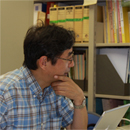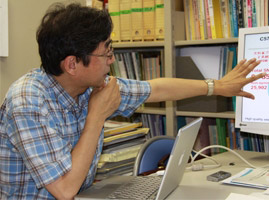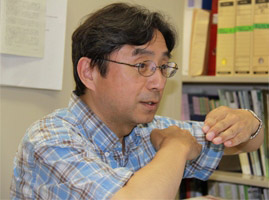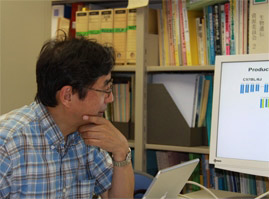SHIROISHI, Toshihiko D. Sc., Professor

- Mammalian Genetics Laboratory, Shiroishi Group
From Mishima to the world
Mice have become an indispensable model organism in today’s life science and medical research. Using mice, researchers artificially destroy or modify genes or analyze naturally occurring mutants to study the relationship between phenotypes and genotypes and investigate if the relationship thus identified is also found in humans, thereby enriching knowledge about humans.
- Japanese-born research resources
 There are over 400 strains of laboratory mice today. Most of them are US-born, derived from European wild mice. Unfortunately, there have been very few genetic resources (research model organisms) of Japanese origin. All representative model organisms not only mice but also Nematodes, Drosophila and Arabidopsis thaliana originated either in the US or Europe. Prof. Toshihiko SHIROISHI, determined to produce his own genetic resources, has turned his attention to Japanese wild mice.
There are over 400 strains of laboratory mice today. Most of them are US-born, derived from European wild mice. Unfortunately, there have been very few genetic resources (research model organisms) of Japanese origin. All representative model organisms not only mice but also Nematodes, Drosophila and Arabidopsis thaliana originated either in the US or Europe. Prof. Toshihiko SHIROISHI, determined to produce his own genetic resources, has turned his attention to Japanese wild mice.- Japanese and European mice have many different phenotypes even if they are the same species. For example, the Japanese wild mouse-derived strain MSM/Ms (commonly known as Mishima or MSM) found in Mishima City, where the NIG is located, are more active and smaller in size and have a thrifty-type energy metabolism and an extremely lower incidence of cancer development than the European C57BL/6 (commonly known as B6), which is frequently used in today’s biomedical research. If genes responsible for these differences are identified, genes associated with human metabolism and cancer risk may also be detected.
- However, it takes several years to link one phenotype with a gene because it is necessary to continue breeding mice for over ten generations in the linkage analysis in which genes of phenotypes are sought. To break this constraint and accelerate research, Dr. Shiroishi has produced “consomic” strains between MSM and B6.
- Mice produced after a lot of time and effort
 “Consomic” means having one chromosome derived from a strain different from the one of the other chromosomes; for example, Chromosome 1 is 100% derived from MSM while all the other chromosomes are from B6. Dr. Shiroishi has spent more than ten years to produce 29 consomic strains, introducing MSM-derived chromosome 1 to 19, X and Y chromosomes and mitochondria DNA onto the B6 genetic background. By comparing phenotypes of the consomic strains to those of the original B6 enables to promptly identify chromosomal regions associated with specific phenotypes. By gradually narrowing the MSM-derived chromosomal regions, Dr. Shiroishi has already identified over 400 loci related to specific phenotypes. Moreover, his group has completed total genome sequencing of MSM and found 9,735,746 SNPs (single nucleotide polymorphism) including 25,902 SNPs that cause amino acid substitutions between MSM and B6. This information should enable him to narrow down causes of the phenotypes to the nucleotide level.
“Consomic” means having one chromosome derived from a strain different from the one of the other chromosomes; for example, Chromosome 1 is 100% derived from MSM while all the other chromosomes are from B6. Dr. Shiroishi has spent more than ten years to produce 29 consomic strains, introducing MSM-derived chromosome 1 to 19, X and Y chromosomes and mitochondria DNA onto the B6 genetic background. By comparing phenotypes of the consomic strains to those of the original B6 enables to promptly identify chromosomal regions associated with specific phenotypes. By gradually narrowing the MSM-derived chromosomal regions, Dr. Shiroishi has already identified over 400 loci related to specific phenotypes. Moreover, his group has completed total genome sequencing of MSM and found 9,735,746 SNPs (single nucleotide polymorphism) including 25,902 SNPs that cause amino acid substitutions between MSM and B6. This information should enable him to narrow down causes of the phenotypes to the nucleotide level.- A strong research base in Mishima
 Regarding MSM strain, not only genomic information and consomic strains but also ES cells, necessary for producing knockout mice, and BAC library have been developed by collaborative researches. Moreover, the NIG is one of Japan’s next-generation genomic sequencing centers. In other words, the NIG represents an ideal environment well equipped with research resources, information and equipment for new mouse genetics.
Regarding MSM strain, not only genomic information and consomic strains but also ES cells, necessary for producing knockout mice, and BAC library have been developed by collaborative researches. Moreover, the NIG is one of Japan’s next-generation genomic sequencing centers. In other words, the NIG represents an ideal environment well equipped with research resources, information and equipment for new mouse genetics.- Mice native to Mishima, a city with a commanding view of Mt. Fuji, have become a globally utilized research tool. “How to use them depends on what researchers find interesting, or their senses and ideas,” says Dr. Shiroishi. He looks forward to the arrival of students with great mental flexibility, who can make the optimal use of this genetic research base perfected over ten years.
- (Interviewed by Leave a nest Co.,Ltd on Jul. 12, 2009)
















